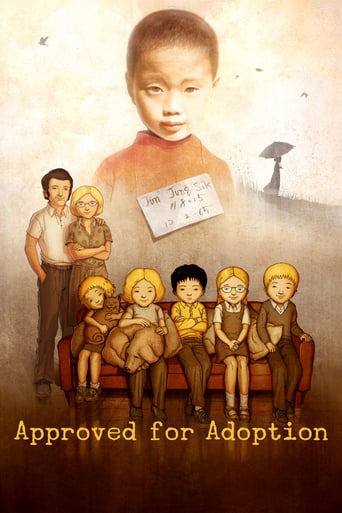runamokprods
A heartfelt, unique, mostly animated film, this off-beat documentary is the autobiographic tale of co-director Jung's adoption in Korea by a Belgian family when he was a young orphan. It gives a good sense of the strangeness of leaving your homeland and culture at age 5, and the difficulties of growing up in with a family where you don't look like everyone else. It's particularly effective at capturing the lingering paranoia that you're not always loved as deeply as the 'real' kids, and suggests there may even be some hints of truth in that fear re Jung's adoptive parents, at least from a child's perception. And yet the film is ultimately embracing of his adoption, without denying its challenges. Jung himself has grown-up to be a successful illustrator, and his drawings form the basis of the animation that make up about 80% of the film (the rest are old home movies and stills, along with shots of the adult Jung pondering, and visiting Korea). So why don't I love the film more? It's brave, honest, and different. But it sometimes feels both emotionally muted and repetitive. As personal as the story is, the stylistic choices, while interesting, make it feel like a fable more than a person's real experience. This is fed by the adult Jung's narration being read by an actor, not the man himself. And there is something artificial in the performance. I watched the film twice, and appreciated it both times, but was never quite as swept up in it as I longed to be. That may be my loss, my limitation. I can imagine someone else being deeply moved. One to see for yourself.
edezagon
I read the 2 comic strip books and had anxiously been waiting for the film. I loved both. The film goes more into his origins, but in the end, it's very close to the book. The animation and drawings are art. Brilliant. As the mother of an adopted child, it's wonderful to see the subject taken to such a level, both emotionally and artistically. Go see it. The story flows easily and takes you to his origins, or what he remembers of them, to his arrival in Belgium, where he was adopted. There are a few passages missing in the movie from the book, which I would have liked to have seen, but it is still very faithful to the book. Now, I am waiting for the third volume then the second movie. I think it will appeal also to those with no adoption links, but will make you realize some things you may never ave thought of regarding adoption and even family dynamics. Enjoy
guy-bellinger
Another achievement in recent adult animation ("A Scanner darkly", "Persepolis", "Waltz With Bashir", "Chico and Rita"), "Couleur de peau : miel" is a new illustration of how profound and innovative this film genre, once deemed reserved for children, can get.Directed by Laurent Boileau and Jung, based on a graphic novel (or more accurately a graphic autobiography) by the latter, "Couleur de peau : miel" revisits the cartoonist's youth from age six to twenty. Catoonist Jun could have been content to align a series of colorful childhood memories, which would already have given rise to a pleasant show, but he has set the bar much higher. Refusing anecdote, his in-depth screenplay examines candidly the notions of adoption, of difference, of family relationships, of self-identity... As a matter of fact, "Couleur de peau : miel" is not only about what Jung DID as a child and as a teenager, but mostly about what he FELT, both consciously and subconsciously. Nor is it an ode to Jung as a martyr, since the author shows without any taboos what a difficult a child he was and does not leave untold all the silly things he did at this period of his life. The result of such an approach is impressive. Rarely indeed has a movie been more eloquent about what it is like to be an adopted child from a different civilization, but also about what it means to be the parents of such children. In turns amusing and poignant, this short film captivates you as of the first minutes of its running time but a high point is attained in the final scenes when the young man finally comes to terms with his parents (in particular with his adoptive mother, unable as she was to express her love for him), with his native country and with himself ; it really puts tears in your eyes.Another quality to be mentioned is that 75 minutes are enough for Jung and his co-director, documentary-maker Laurent Boileau, to deal with such a complex issue fully. Such a feat is obtained - at least partly - in varying the angles of approach, which means resorting to various gauges (35mm and 8mm), sources (home movies, newsreels, real- life views of Jung back in Seoul for the first time at age 46) and techniques (2D and 3D animation). Such a combination, probably unseen before (I may be mistaken but no other example of such a mix comes to my mind), greatly enhances the effectiveness of the whole thing. In any case, this is another example that brevity is not alien to density. On the contrary.If you are a fan of "Persepolis" or "Waltz With Bashir", it would be surprising if you disliked "Couleur de peau: miel". I would not recommend it to young children though but those over twelve may appreciate it and learn from this beautiful work of art.


